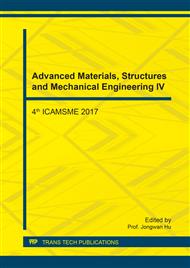p.243
p.248
p.254
p.259
p.267
p.272
p.279
p.285
p.292
Geometric Configuration Analysis on the Inside Profile of the Vole’s Clawed Toes
Abstract:
The inside profile curves data points of vole’s clawed toes had been analyzed. The least squares fitting method was used to analyze the inside profile curves data points for fitting mathematical model and fitted curves were expressed by polynomial equations. According to the curvature of fitted curves, the geometrical characteristics of the fitted curves were summed up. The variation curvature of inside profile curve from the second clawed toe was similar to the third and fourth. They both had two maximum vales and two minimum vales, and the larger maximum vales were at the tiptoes, the smaller maximum vales were at the end of toes’ babies. The fifth clawed toe had only one maximum vale and two minimum vales. And one of the minimum vales was at the tiptoe, another was at the end of toe’s baby. The maximum vale was in the center of the fifth clawed toe’s body. This concluded that the geometrical characteristics of inside profile curves were very important for vole’s digging ability. This provided design reference of energy-saving and high efficient for structure design of soil contact surface of tillage components.
Info:
Periodical:
Pages:
267-271
Citation:
Online since:
November 2017
Authors:
Keywords:
Price:
Сopyright:
© 2017 Trans Tech Publications Ltd. All Rights Reserved
Share:
Citation:


